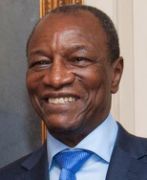
Guinea

Brief Overview
The West African nation of Guinea is bordered to the north by Guinea Bissau, Senegal, and Mali, and to the south by Sierra Leone, Liberia, and Côte d’Ivoire. In 2017, the country had a population of 12.7 million.
Political Context
President Alpha Condé was re-elected to a second term in office with 57% of the vote in October 2015. In May 2018, President Condé announced a cabinet reshuffle and appointed Kassory Fofana prime minister. Presidential elections are scheduled for 2020.
Economic Overview
Growth stood at around 10% in 2016 and 2017, before slowing to 5.8% in 2018. Growth nevertheless remains robust, driven by foreign direct investment (FDI) in the mining sector. The mining industry grew at an annual rate of roughly 50% in 2016 and 2017, while the non-mining sector posted a 5.4% growth rate in 2018, with investment in infrastructure and the expansion of the primary and tertiary sectors remaining strong.
Inflation, which stood at 9.8% in 2018, approached double-digit levels, owing to an increase in fuel prices and electricity rates.
The fiscal balance improved from -2.1% of GDP in 2017 to -1.1% in 2018, owing to reduced subsidies on fuel prices, higher electricity rates, and constraints on hiring and promotions in the public sector.
Despite these measures, tax revenue fell by 0.8% of GDP to 12.5% in 2018. An extraordinary transfer of 0.4% of GDP from the Post and Telecommunications Regulatory Agency helped improve the fiscal balance.
With respect to expenditure, investments fell by 0.8% of GDP despite an increase in capital expenditure of 0.7% of GDP financed by external resources. The budget deficit was essentially financed by external resources, which was due to the fall in domestic funding.
The risk of debt distress remains moderate, even though non-concessional external borrowing increased in 2018. The total public debt-to-GDP ratio fell from 39.6% in 2017 to 37.6% in 2018.
The Guinean economy continues to grapple with two main risks in 2019: the country must sustain macroeconomic and fiscal reforms and ensure social and political stability. The slow pace of infrastructure development could decelerate growth. On the external front, lower commodity prices and a global economic slowdown could undermine growth in Guinea.

The Republic of Guinea
Capital: Conakry
Population: 1.3 million
Area: 36,125 sq km (13,948 sq miles)
Major languages: Portuguese, Crioulo – a form of Portuguese, African languages
Major religions: Indigenous beliefs, Islam, Christianity
Life expectancy: 47 years (men), 50 years (women)
Currency: CFA (Communaute Financiere Africaine) franc
UN, World Bank

Development Challenges
Agriculture and natural resources, as well as the manufacturing and services sectors, are some of Guinea’s economic assets. Agriculture is the country’s main source of employment and is critical for poverty reduction and rural development, providing income for 57% of rural households and employment for 52% of the workforce.
While natural conditions are favorable for growth, Guinea must improve its governance if it hopes to fully realize this potential and step up the structural transformation process. Guinea is becoming increasingly vulnerable to climate change, with an overall rise in average temperatures and a decline in annual rainfall, particularly in the northwestern and northeastern regions.
Guinea is endowed with vast natural resources, especially mining and hydropower resources, which could generate substantial income. Experience shows, however, that mining and hydropower can have serious negative effects, both direct and indirect, on biodiversity and the environment. These potential risks will require careful management.
Another major challenge facing Guinea are the gender gaps in the areas of education and agricultural productivity, and with regard to employment and decision-making opportunities. Taken together, these factors diminish women’s prospects and undermine the country’s growth trajectory. Other major constraints include weak human capital (with low literacy rates), a poor health system, a lack of quality agricultural inputs, weak sector and local government management capacity, limited access to finance, and high unemployment, especially among young people.
Physical Contacts of the Presidency
Name of Minister:
Address:
Telephone:
Fax:
Physical Contacts of the Prime Minister’s Office
Name of Minister:
Address:
Telephone:
Fax:
Physical Contacts of the National Assembly
Name of Speaker of the House:
Address:
Telephone:
Fax:
Physical Contacts of the Chief Of State and Cabinet Ministers
Name of Minister:
Address:
Telephone:
Fax:
Physical Contacts of the Ministry of Interior
Name of Minister:
Address:
Telephone:
Fax
Physical Contacts of the Ministry of Justice
Name of Minister:
Address:
Telephone:
Fax:
Physical Contacts of the Ministry of Foreign Affairs
Name of Minister:
Address:
Telephone:
Fax:
Physical Contacts of the Ministry of Women’s Affairs
Name of Minister:
Address:
Telephone:
Fax:
Physical Contacts of the National Human Rights Commission
Name of Minister:
Address:
Telephone:
Fax:
Physical Contacts of the Police
Name of Inspector General:
Address:
Telephone:
Fax:
Physical Contacts of the Military
Name of Inspector General:
Address:
Telephone:
Fax:
Important Information of Key Human Rights Issues in Guinea
Number Prisons in Guinea
Number Prisoners in Guinea:
Secret Detention Centres:
Police Stations in Guinea
What are the current and ongoing human rights issues in Guinea?
(1) Freedom of the Press
(2) Human Rights Defenders Issues
(3) Impunity
African Union (AU)
Joined the OAU in 1987
Signed the Constitutive Act of The African Union on:
Ratified:Instrument Deposited:
Signed:
Ratified:
Instrument Deposited:
Signed:
Ratified:
Instrument Deposited:
Signed: –
Ratified: –
Instrument Deposited: –
4.Protocol on Amendments to the Protocol on the Statute of the African Court of Justice and Human Rights
Signed: –
Ratified: –
Instrument Deposited: –
Signed: –
Ratified: –
Instrument Deposited: –
Signed: –
Ratified: –
Instrument Deposited: –
Signed: –
Ratified: –
Instrument Deposited: –
Signed: –
Ratified: –
Instrument Deposited: –
Signed: –
Ratified: –
Instrument Deposited: –
Signed: –
Ratified: –
Instrument Deposited: –
Signed: –
Ratified: –
Instrument Deposited: –
Signed: –
Ratified: –
Instrument Deposited: –
Signed: –
Ratified: –
Instrument Deposited: –
Signed: –
Ratified: –
Instrument Deposited: –